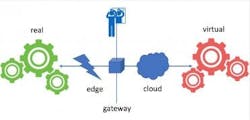Digital twin technology has been trending in the news for quite a while, yet it should be no surprise that it’s in the Industrial Internet of Things where the concept of a virtual
representation of a physical product or system will be the most valuable.
After all, when your business involves designing, producing or maintaining equipment, your finger should remain firmly on the pulse of that machinery. When real-time monitoring is not feasible and critical information arrives too late, costly mechanical failures can occur.
Imagine that your systems are able to operate at peak efficiency, with the sensors and real-time tracking of operations data providing the ability to anticipate repairs when you aren’t within physical proximity. That’s the promise of the digital twin.
The digital twin has a natural home in the IIoT. The components of a CAD model--the design parameters, the operating state, the environment--can all be elements of the digital twin representation. Think of the twin as a body where nerve endings live in the sensors deployed on the machines.
The importance of the IIoT digital twin
The digital twin paradigm enables manufacturers to do two things--operate factories efficiently and gain timely insights into the performance of the products manufactured in these factories.
The real-time view of shop floors provided by the digital twin enables operational efficiency. The operating state of manufacturing equipment can be juxtaposed with the safe or desired operational envelope, setting the stage for a continuous feedback loop.
Additionally, monitoring the field performance of the manufactured products via their digital twin provides a window with an ongoing view, comparing actual usage with the anticipated usage, as reflected in design parameters of the product. This process generates valuable real-time feedback for improving the design process.
Does a digital twin perform differently in smart manufacturing?
While the notion of a digital twin is similar across various markets, what differentiates the role of the digital twin in the manufacturing process is the granularity of information and the near real-time updates.
In the cloud, a machine’s digital twin makes its current state and prior operating history available at a level of detail that’s only possible with the IoT. Once upon a time, these machines were instrumented to catch alerts based on high temperatures or high vibration levels, and managed at the edge. Now, the maintenance engineer, the designer, the marketer, or even the CEO of the company has a continuous window into the life of the machine, viewing the granular detail of specific machines or the aggregated metrics level. The result is quicker and more informed decision-making.
What to consider when implementing digital twin technology
Whatever your market, consider the key operating parameters that will provide enough understanding of the machine or product that will optimize the size and complexity of the digital twin. Companies can certainly start small and then refine their requirements, based on their experience operating a digital twin.
As one of Gartner’s Top 10 Strategic Technology Trends for 2017, the digital twin is predicted to “have substantial disruptive potential across industries.”
Indeed, industrial operations will surely be transformed by the ability to leverage prior investments in big data technologies and machine learning/cognitive algorithms to synchronize the performance of products with the reality of customer experiences.
Within the complex operations of the IIoT, digital twins represent the future.





